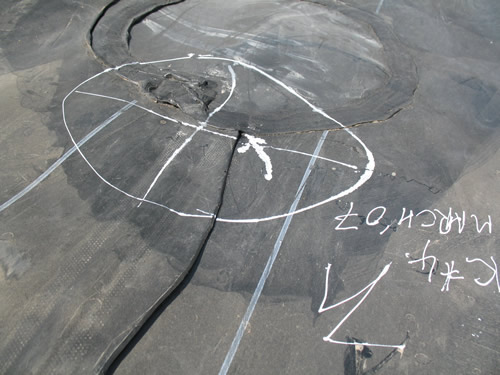I-CORP recently performed the first electrical integrity survey in India on an HDPE lining system incorporating a conductive geotextile. The conductive geotextile was placed between the geomembrane and the drainage geonet because of the extremely dry (nonconductive) subgrade soil conditions. It was also the first time in 20 years of performing liner leak location surveys that I have slipped down the slope, fortunately into shallow (600 mm) water, but then not water you would choose to swim in. Even the Leak Sensors meter got a dunking. But within an hour it was dried out and working as new. Previously, spark testing had been done before and after concrete aerator pads had been placed on the HDPE geomembrane. The concrete was carried in baskets on the heads of women from the mixing location onto the liner. In fact, the complete liner was placed manually without any mechanical equipment assistance. The original design, per local regulation, was to completely cover the liner with bricks. Fortunately this requirement was obviated by the engineering consultants.
A wading survey was performed on the water covered floor, and a water lance survey on the exposed slopes. The approximately 60 x 100 m lagoon with 2:1 slopes generated 4 leak indications. Two were on the floor at corners of the aerator pads, and two were on the slopes – one caused by a dropped tool, and the other where a peripheral weld bead on a patch crossed the seam being repaired (see below). The latter is a very common location for small leaks.
 |
| Weld bead on the patch which crossed the seam being repaired |
India, what a fascinating country. Camels pulling trailers (so slowly) on the sides of a toll road. Mothers riding side-saddle on scooters while holding babies, Tuk-Tuk taxis with 8 or more people aboard, requested honking of horns, where Jet Airways serves a choice of dinners on a 1 hr flight, where "Dr. Ian" was not allowed to carry anything, where the most useful hardware is a bundle of 1 m long steel wires used to tie, seal, connect, restrain, and clamp anything and everything.
This country is about to explode into geosynthetics. We need to help it happen properly.
The first locally made geomembrane did not meet GRI.GM13 specification and was rejected. The local installer was not able to install the foreign supplied replacement and achieve the required quality in the available time. A welding machine spent three weeks in customs before it was released, while another machine shipped by courier simply disappeared. Yet I walked through customs with my big white box and a rifle case (containing only survey probes) with no problem at all. Thank heavens.
India. You need to be there.











